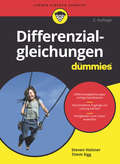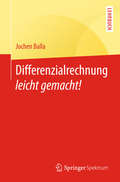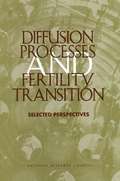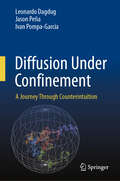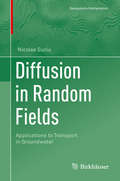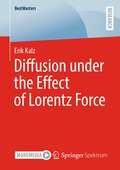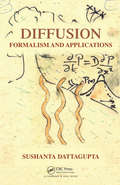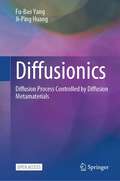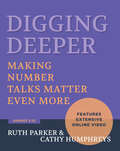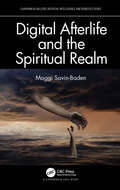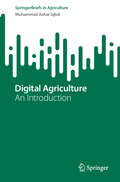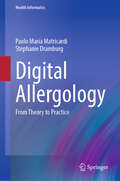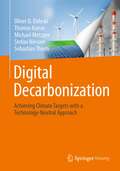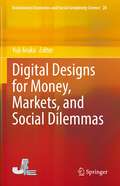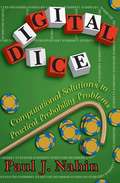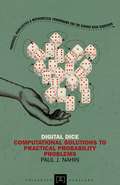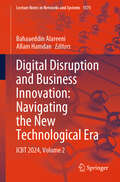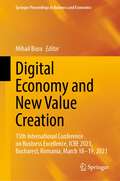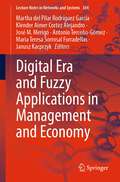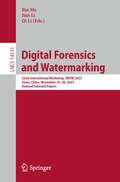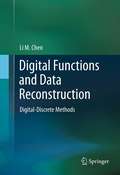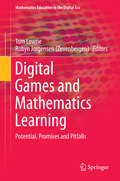- Table View
- List View
Differenzialgleichungen für Dummies (Für Dummies)
by Steven Holzner Timm SiggIn diesem Buch lernen Sie, wie Sie mit Differenzialgleichungen aller Schwierigkeitsstufen umgehen: Sie starten mit Differenzialgleichungen erster Ordnung und erfahren, was mit separierbaren Differenzialgleichungen zu tun ist und was exakte Differenzialgleichungen sind. Anschließend begegnen Ihnen lineare homogene und lineare inhomogene Differenzialgleichungen höherer Ordnung. Lernen Sie die Methode der unbestimmten Koeffizienten und die Methode der Parametervariation kennen. Den wirklich schweren Brocken rücken Sie mit Laplace-Transformationen und Reihenlösungen zu Leibe. Und wenn gar nichts mehr geht, bleiben Ihnen ja immer noch die numerischen Lösungen. Sie funktionieren fast immer.
Differenzialgleichungen in elementarer Darstellung: Eine Einführung für das gymnasiale Lehramt
by Wolfgang LayDieses Lehrbuch leitet von den klassischen Schulinhalten der Analysis direkt zu einer Kategorisierung und Analyse spezieller (insbesondere linearer) Differenzialgleichungen über. Es betrachtet somit die klassische Analysis aus einer ungewohnten Perspektive und vermittelt inhaltlich zwischen dem mathematischen Denken an Gymnasien einerseits und an Hochschulen/Universitäten andererseits. Dabei werden Definitionen weniger formal, sondern vielmehr als Handlungsanweisung, also funktional betrachtet. Beim mathematischen Beweis geht es weniger darum, eine Wahrheit zu entdecken, als vielmehr darum, eine Einsicht zu vermitteln. Die verwendeten mathematischen Zeichen erheben keinen Absolutheitsanspruch, sondern sollen im Betrachter ein Bild erzeugen. Dieses Buch möchte so eine Weiterentwicklung in der Didaktik anstoßen; es richtet sich daher primär an Studierende und Dozenten im gymnasialen Lehramt der Mathematik, aber auch an SchülerInnen der gymnasialen Kursstufe, welche ein mathematikaffines Studium ins Auge fassen und daher den Übergang von der gymnasialen Kursstufe zum Studium der Mathematik oder eines mathematikaffinen Faches zu bewältigen haben. Es möchte sie dazu ermutigen, die Mathematik als einen großen Werkzeugkasten zu begreifen, mit dessen Hilfe sich auf unglaublich vielen Gebieten alltägliche wie nicht alltägliche Fragen lösen und Sachverhalte quantifizieren lassen.
Differenzialrechnung leicht gemacht!
by Jochen BallaDas vorliegende Buch bietet eine leicht lesbare Darstellung der Kerninhalte der Differenzialrechnung und richtet sich an Studierende der Physik, der Ingenieur- und Wirtschaftswissenschaften sowie an Mathematikstudierende, die einen gut verständlichen Zugang suchen.Neben den allgemeinen Inhalten der Differenzialrechnung bespricht der Autor auch die Taylor-Formel und ihre Anwendungen.Eine separat lesbare Einführung in die komplexen Zahlen und die Euler-Formel, ebenfalls Grundlage für viele praktische Anwendungen, helfen beim Start in die Höhere Mathematik.Das Lehrbuch bietet verschiedene Hilfestellungen, die den Zugang erleichtern: 135 Lesehilfen helfen über schwierige Stellen hinweg37 Zwischenfragen mit Antworten regen zum Nachdenken an68 Übungsaufgaben mit ausführlichen Lösungen unterstützen das vertiefende Studium"Das Wichtigste in Kürze" am Ende eines jeden Kapitels.
Diffusion Processes And Fertility Transition: Selected Perspectives
by Committee on PopulationThis volume is part of an effort to review what is known about the determinants of fertility transition in developing countries and to identify lessons that might lead to policies aimed at lowering fertility. It addresses the roles of diffusion processes, ideational change, social networks, and mass communications in changing behavior and values, especially as related to childbearing. A new body of empirical research is currently emerging from studies of social networks in Asia (Thailand, Taiwan, Korea), Latin America (Costa Rica), and Sub-Saharan Africa (Kenya, Malawi, Ghana). Given the potential significance of social interactions to the design of effective family planning programs in high-fertility settings, efforts to synthesize this emerging body of literature are clearly important.
Diffusion Under Confinement: A Journey Through Counterintuition
by Leonardo Dagdug Jason Peña Ivan Pompa-GarcíaThis book offers the reader a journey through the counterintuitive nature of Brownian motion under confinement. Diffusion is a universal phenomenon that controls a wide range of physical, chemical, and biological processes. The transport of spatially-constrained molecules and small particles is ubiquitous in nature and technology and plays an essential role in different processes. Understanding the physics of diffusion under conditions of confinement is essential for a number of biological phenomena and potential technological applications in micro- and nanofluidics, among others. Studies on diffusion under confinement are typically difficult to understand for young scientists and students because of the extensive background on diffusion processes, physics, and mathematics that is required. All of this information is provided in this book, which is essentially self-contained as a result of the authors’ efforts to make it accessible to an audience of students from a variety of different backgrounds. The book also provides the necessary mathematical details so students can follow the technical process required to solve each problem. Readers will also find detailed explanations of the main results based on the last 30 years of research devoted to studying diffusion under confinement. The authors approach the physical problem from various angles and discuss the role of geometries and boundary conditions in diffusion. This textbook serves as a comprehensive and modern overview of Brownian motion under confinement and is intended for young scientists, graduate students, and advanced undergraduates in physics, physical chemistry, biology, chemistry, chemical engineering, biochemistry, bioengineering, and polymer and material sciences.
Diffusion in Random Fields: Applications to Transport in Groundwater (Geosystems Mathematics)
by Nicolae SuciuThis book presents, in an accessible and self-consistent way, the theory of diffusion in random velocity fields, together with robust numerical simulation approaches. The focus is on transport processes in natural porous media, with applications to contaminant transport in groundwater. Starting from basic information on stochastic processes, more challenging issues are subsequently addressed, such as the correlation structure of the diffusion process in random fields, the relation between memory effects and ergodic properties, derivation and parameterizations of evolution equations for probability densities, and the relation between measurements and spatio-temporal upscaling.Written for readers with a background in applied mathematics, engineering, physics or geophysics, the book offers an essential basis for further research in the stochastic modeling of groundwater systems.
Diffusion under the Effect of Lorentz Force (BestMasters)
by Erik KalzIt is generally believed that collisions of particles reduce the self-diffusion coefficient. In this book, Erik Kalz shows that in classical systems under the effect of Lorentz force, which are characterized by diffusion tensors with antisymmetric elements, collisions surprisingly can enhance self-diffusion. In these systems, due to an inherent curving effect, the motion of particles is facilitated, instead of hindered by collisions. Consistent with this the author finds that the collective diffusion remains unaffected. Using a geometric model, he theoretically predicts a magnetic field governed crossover from a reduced to an enhanced self-diffusion. The physical interpretation is quantitatively supported by the force autocorrelation function, which turns negative with increasing the magnetic field. Using Brownian-dynamics simulations, he validates the predictions.
Diffusion: Formalism and Applications
by Sushanta DattaguptaWithin a unifying framework, Diffusion: Formalism and Applications covers both classical and quantum domains, along with numerous applications. The author explores the more than two centuries-old history of diffusion, expertly weaving together a variety of topics from physics, mathematics, chemistry, and biology. The book examines the two distinct
Diffusionics: Diffusion Process Controlled by Diffusion Metamaterials
by Ji-Ping Huang Fu-Bao YangThis open access book presents a comprehensive exploration of diffusion metamaterials that control energy and mass diffusion. Currently, if from the perspective of governing equations, diffusion metamaterials and wave metamaterials (pioneered by J. B. Pendry in the 1990s) are recognised as the two most prominent branches in the field of metamaterials. These two branches differ in their emphasis on the diffusion equation (as the governing equation) and time-dependent characteristic lengths in diffusion metamaterials, as opposed to the wave equation (as the governing equation) and time-independent characteristic lengths in wave metamaterials. Organized into three distinct parts – 'Thermal Diffusion Metamaterials', 'Particle Diffusion Metamaterials', and 'Plasma Diffusion Metamaterials' – this book offers a rigorous exploration spanning physics, engineering, and materials science, aimed at advancing our understanding of diffusion processes controlled by diffusion metamaterials. Incorporating foundational theory, computational simulations, and laboratory experiments, the book equips researchers and scholars across these disciplines with comprehensive methods, insights, and results pivotal to the advancement of diffusion control. Beyond facilitating interdisciplinary discourse, the book serves as a catalyst for innovative breakthroughs at the crossroads of physics, thermodynamics, and materials science. Essentially, readers will acquire profound insights that empower them to spearhead advancements in diffusion science (diffusionics) and the engineering of metamaterials.
Diffusions, Markov Processes, and Martingales
by David Williams L.C.G. RogersTogether with Volume 2, Ito Calculus (Wiley, 1987), this volume helps to equip readers for research into a subject of great intrinsic interest and of widespread applicability in physics, biology, engineering, and economics. Chapter I, on Brownian motion, is now much more extensive and wide-ranging, and covers much work done since the first edition appeared in 1979. Chapter II, on classical theory, is now a highly systematic account, with detailed proofs, of what every probabilist must know. Chapter III, on Markov processes, is reproduced without much modification, except that some of the functional analysis is given fuller treatment. Annotation copyright by Book News, Inc. , Portland, OR
Digging Deeper: Making Number Talks Matter Even More, Grades 3-10
by Cathy Humphreys Ruth ParkerMaking the transition to student-centered learning begins with finding ways to get students to share their thinking, something that can be particularly challenging for older learners. Authors Ruth Parker and Cathy Humphreys return with Digging Deeper: Making Number Talks Matter Even More, Grades 3-10, taking the readers into classrooms where their Number Talks routines are taught.In this comprehensive sequel to their best-selling book, Making Number Talks Matter, Parker and Humphreys apply their 15 minute lessons to older grade levels to inspire and initiate math talks. Through vignettes in the book, you'll meet other teachers learning how to listen closely to students and how to prompt them into figuring out solutions to problems. You will learn how to make on-the-spot decisions, continually advancing and deepening the conversation. Digging Deeper includes: Sample Problems: Digging Deeper is filled with a range of Number Talks problems, 10-15 minute warm-up routines that lend themselves to mental math and comparison of strategiesNavigating Rough Spots: Learn how to create a safe environment for tricky, problematic, or challenging student discussions that can arise when talking through problems and sharing ideasResponding to Mistakes: Ways to handle misconceptions and mathematical errors that come up during the course of Number Talk conversationsDigging Deeper is filled with teaching tips for using wait time between problems more efficiently, honoring student contributions while still correcting errors, and teaching concepts while nudging independent thinking. Through daily practice and open conversation, you can make Number Talks matter more.
Digital Afterlife and the Spiritual Realm (Chapman & Hall/CRC Artificial Intelligence and Robotics Series)
by Maggi Savin-BadenFew religious leaders have examined the potential for the positive impact of digital media and digital immortality creation in religious contexts. It is evident that there have been recent moves away from traditional funeral services focusing on the transition of the deceased into the future world beyond, towards a rise of memorial content within funerals and commemorative events. This has heralded shifts in afterlife beliefs by replacing them, to all intents and purposes, by attitudes to this life. Digital Afterlife and the Spiritual Realm explores the ways in which digital media and digital afterlife creation affects social and religious understandings of death and the afterlife. Features Understands the impact of digital media on those living and those working with the bereaved Explores the impact of digital memorialisation post death Examines the ways in which digital media may be changing conceptions and theologies of death For many people, digital afterlife and the spiritual realm largely remains an area that is both inchoate and confusing. This book will begin to unravel some of this bafflement.
Digital Agriculture: An Introduction (SpringerBriefs in Agriculture)
by Muhammad Azhar IqbalThe success of modern-day agriculture lies in the digitalization of agricultural systems. The primary aim of this book is to provide a starting point to understand the fundamentals and design of digital agriculture systems with reference to the enabling technologies that deal with the production, improvement, and protection of crops/plants and livestock. The other associated objectives of this book include the explanation of the design and deployment of IoT-based digital agriculture systems in such a simple way that agriculture students understand straightforwardly. Therefore, this book is an effort to partially fill the gap associated with the understanding of the development and deployment of digital agriculture systems (including both precision and smart farming). We believe that with the provided details of enabling technologies and their usage in digital agriculture systems, agriculture students will find it easier to comprehend the designing of small-/large-scale IoT-based digital agriculture systems. This book provides insight into different technologies, architectures, and case studies that will ultimately help students to understand the concept of Digital Agriculture and its related applications. It enables students to realize the importance of open issues and future challenges of digital agriculture systems.
Digital Allergology: From Theory to Practice (Health Informatics)
by Paolo Maria Matricardi Stephanie DramburgSeveral hundred million citizens suffer from allergic diseases, ranging from watery eyes to life-threatening anaphylactic shock. In addition to the individual reduction of quality of life, allergies have an impact on workplace efficiency and healthcare budgets. Although new developments of diagnostic assays are advancing quickly, their implementation in clinical routine is challenged by several barriers. This is very evident in the EU, where the gap between technological progress and modern diagnosis is rapidly growing. Digital Health tackles this challenge by providing novel tools, supporting allergy diagnosis and treatment through internet platforms, medical devices, smart-phone apps, telemedicine tools, etc. The integration of Digital Health procedures and tools in the management of allergic diseases will allow personalized diagnostic and therapeutic approaches with 24/7 interactivity between patients and professional healthcare. It will enable the delivery of faster, relevant healthcare support via real-time accessibility of key information for specialists, at primary health care centers, pharmacies and the patient´s home. "Digital Allergology: From Theory to Practice" is unique in comprehensively approaching "Digital Allergology", starting with the general frame to more specific parts on specific allergic diseases, public health as well as research and perspectives from several countries. Allergology being transversal, and covering dozen sub-specialty areas, the list of authors, each one with specific expertise in Digital Health applied to his/her sub-area of interest, is heterogeneous: same sub-areas will be seen from different perspectives. Built for allergists and other clinicians with a strong interest in allergic diseases, it will be a stimulating read for allied health professionals, insurance companies, public health administrators, manufacturers in allergen immunotherapy, IT developers, and clinical scientists.
Digital Decarbonization: Achieving climate targets with a technology-neutral approach
by Thomas Kaiser Oliver D. Doleski Michael Metzger Stefan Niessen Sebastian ThiemDecarbonization through optimized energy flows. In this book you will learn how a significant reduction in climate changing greenhouse gas emissions can be achieved through systemic optimization of our energy systems. The authors clearly demonstrate how energy-intensive processes can be optimized flexibly by using technology-neutral simulation methods to ensure that significantly fewer greenhouse gases are emitted.Such field-tested, data-based energy models described in this publication prove that "digital decarbonization" enables an economy that releases significantly fewer climate changing emissions while maintaining its production output. This is a promising message in view of ongoing climate change.
Digital Designs for Money, Markets, and Social Dilemmas (Evolutionary Economics and Social Complexity Science #28)
by Yuji ArukaAn innovative feature of this book is its econocentric structure, focusing on digital designs. From the outset, econocentrism is assumed to be a core engine of capitalism, like money. The new coronavirus pandemic has changed lifestyles worldwide, which are unlikely ever to return in their original form. This great transformation will change the nature of the socio-economic system itself and will be centered on digital designs. At present, money already is beginning to undergo a major revolution in that sense. Many books dealing with digital designs and innovations have been published, but few if any of them focus on monetary and analytical methods in the way that this present volume does.The book then contains 6 parts: Evolution of money and thinking complexities in the AI era; Goods market and the future of labor market; Computational social approaches to social dilemmas, smart city, cryptocurrencies; Artificial market experiments; The randomness and high frequencies in financial data; Other trading strategy issues and the effects of AI usage. These issues may be indispensable subjects in our age. Study these subject, and have a step forward to the future society!
Digital Dice: Computational Solutions to Practical Probability Problems
by Paul J. NahinSome probability problems are so difficult that they stump the smartest mathematicians. But even the hardest of these problems can often be solved with a computer and a Monte Carlo simulation, in which a random-number generator simulates a physical process, such as a million rolls of a pair of dice. This is what Digital Dice is all about: how to get numerical answers to difficult probability problems without having to solve complicated mathematical equations. Popular-math writer Paul Nahin challenges readers to solve twenty-one difficult but fun problems, from determining the odds of coin-flipping games to figuring out the behavior of elevators. Problems build from relatively easy (deciding whether a dishwasher who breaks most of the dishes at a restaurant during a given week is clumsy or just the victim of randomness) to the very difficult (tackling branching processes of the kind that had to be solved by Manhattan Project mathematician Stanislaw Ulam). In his characteristic style, Nahin brings the problems to life with interesting and odd historical anecdotes. Readers learn, for example, not just how to determine the optimal stopping point in any selection process but that astronomer Johannes Kepler selected his second wife by interviewing eleven women. The book shows readers how to write elementary computer codes using any common programming language, and provides solutions and line-by-line walk-throughs of a MATLAB code for each problem. Digital Dice will appeal to anyone who enjoys popular math or computer science.
Digital Dice: Computational Solutions to Practical Probability Problems (Princeton Puzzlers)
by Paul J. NahinSome probability problems are so difficult that they stump the smartest mathematicians. But even the hardest of these problems can often be solved with a computer and a Monte Carlo simulation, in which a random-number generator simulates a physical process, such as a million rolls of a pair of dice. This is what Digital Dice is all about: how to get numerical answers to difficult probability problems without having to solve complicated mathematical equations. Popular-math writer Paul Nahin challenges readers to solve twenty-one difficult but fun problems, from determining the odds of coin-flipping games to figuring out the behavior of elevators. Problems build from relatively easy (deciding whether a dishwasher who breaks most of the dishes at a restaurant during a given week is clumsy or just the victim of randomness) to the very difficult (tackling branching processes of the kind that had to be solved by Manhattan Project mathematician Stanislaw Ulam). In his characteristic style, Nahin brings the problems to life with interesting and odd historical anecdotes. Readers learn, for example, not just how to determine the optimal stopping point in any selection process but that astronomer Johannes Kepler selected his second wife by interviewing eleven women. The book shows readers how to write elementary computer codes using any common programming language, and provides solutions and line-by-line walk-throughs of a MATLAB code for each problem. Digital Dice will appeal to anyone who enjoys popular math or computer science. In a new preface, Nahin wittily addresses some of the responses he received to the first edition.
Digital Disruption and Business Innovation: ICBT 2024, Volume 2 (Lecture Notes in Networks and Systems #1573)
by Allam Hamdan Bahaaeddin AlareeniThis book examines how organizations across industries are responding to the accelerating pace of technological change, leveraging disruption as a catalyst for growth and competitive advantage. The digital revolution is not merely transforming business operations, it is fundamentally redefining the nature of innovation. Featuring a diverse collection of research, case studies, and expert insights, this book delves into the intersection of digital technologies and business innovation. From artificial intelligence and data analytics to automation and smart platforms, it highlights how emerging tools are driving bold strategies, enhancing customer experiences, and reshaping entire markets. What You&’ll Discover: · Key drivers of digital disruption in today&’s business environment · Innovative responses to change across diverse sectors · Practical frameworks for leading digital transformation ·  
Digital Economy and New Value Creation: 15th International Conference on Business Excellence, ICBE 2021, Bucharest, Romania, March 18–19, 2021 (Springer Proceedings in Business and Economics)
by Mihail BusuThis book constitutes a selection of the best papers from the 15th International Conference on Business Excellence, Digital Economy and New Value Creation, ICBE 2021, held in Bucharest, Romania, in March 2021.This book is a collection of research findings and perspectives related to the digital economy and new value creation, led by the set of improvements and changes in the economic, societal and technological structures and processes towards the effort of reaching the sustainability goals.
Digital Era and Fuzzy Applications in Management and Economy (Lecture Notes in Networks and Systems #384)
by Janusz Kacprzyk Antonio Terceño-Gómez José M. Merigó Martha del Pilar Rodríguez García Klender Aimer Cortez Alejandro Maria Teresa Sorrosal ForradellasThis book aims to contribute to the discussion about the implications of fuzzy logic, neural networks, digital era, and other intelligent techniques on organizations. This book will be very useful for academic researchers and postgraduate students aiming to introduce themselves to the field of quantitative techniques for overcoming uncertain environments and developing models to make decisions. Developments in other theories and socioeconomic and computational changes have shed light on the importance of fuzzy applications in social sciences. The treatment of uncertainty in the economic and business analysis is fundamental and requires instruments compatible with the uncertain environment of economics and business, because most of the traditional models have been overtaken by this reality when trying to make decisions with uncertain information. In the face of information technology, digitization, and uncertainty, organizations confront new opportunities and challenges. In order to take advantage of these opportunities and overcome current and future challenges, it is needed to understand the evolution of these phenomenon.
Digital Forensics and Watermarking: 22nd International Workshop, IWDW 2023, Jinan, China, November 25–26, 2023, Revised Selected Papers (Lecture Notes in Computer Science #14511)
by Qi Li Jian Li Bin MaThis book constitutes the refereed post proceedings of the 22nd International Workshop on Digital Forensics and Watermarking, IWDW 2023, held in Jinan, China, during November 25–26, 2023. The 22 full papers included in this book were carefully reviewed and selected from 48 submissions. The workshop focuses on subjects such as novel research, development and application of digital watermarking, data hiding, and forensic techniques for multimedia security.
Digital Functions and Data Reconstruction
by Li M. ChenDigital Functions and Data Reconstruction: Digital-Discrete Methods provides a solid foundation to the theory of digital functions and its applications to image data analysis, digital object deformation, and data reconstruction. This new method has a unique feature in that it is mainly built on discrete mathematics with connections to classical methods in mathematics and computer sciences. Digitally continuous functions and gradually varied functions were developed in the late 1980s. A. Rosenfeld (1986) proposed digitally continuous functions for digital image analysis, especially to describe the "continuous" component in a digital image, which usually indicates an object. L. Chen (1989) invented gradually varied functions to interpolate a digital surface when the boundary appears to be continuous. In theory, digitally continuous functions are very similar to gradually varied functions. Gradually varied functions are more general in terms of being functions of real numbers; digitally continuous functions are easily extended to the mapping from one digital space to another. This will be the first book about digital functions, which is an important modern research area for digital images and digitalized data processing, and provides an introduction and comprehensive coverage of digital function methods. Digital Functions and Data Reconstruction: Digital-Discrete Methods offers scientists and engineers who deal with digital data a highly accessible, practical, and mathematically sound introduction to the powerful theories of digital topology and functional analysis, while avoiding the more abstruse aspects of these topics.
Digital Games and Mathematics Learning
by Robyn Jorgensen Tom LowrieDigital games offer enormous potential for learning and engagement in mathematics ideas and processes. This volume offers multidisciplinary perspectives--of educators, cognitive scientists, psychologists and sociologists--on how digital games influence the social activities and mathematical ideas of learners/gamers. Contributing authors identify opportunities for broadening current understandings of how mathematical ideas are fostered (and embedded) within digital game environments. In particular, the volume advocates for new and different ways of thinking about mathematics in our digital age--proposing that these mathematical ideas and numeracy practices are distinct from new literacies or multiliteracies. The authors acknowledge that the promise of digital games has not always been realised/fulfilled. There is emerging, and considerable, evidence to suggest that traditional discipline boundaries restrict opportunities for mathematical learning. Throughout the book, what constitutes mathematics learnings and pedagogy is contested. Multidisciplinary viewpoints are used to describe and understand the potential of digital games for learning mathematics and identify current tensions within the field. Mathematics learning is defined as being about problem solving; engagement in mathematical ideas and processes; and social engagement. The artefact, which is the game, shapes the ways in which the gamers engage with the social activity of gaming. In parallel, the book (as a te xtual artefact) will be supported by Springer's online platform--allowing for video and digital communication (including links to relevant websites) to be used as supplementary material and establish a dynamic communication space.
Digital Geographies—Theory, Space, and Communities: A Machine-Generated Literature Review
by Abdul ShabanThis machine-generated volume, with chapter introductions by the human expert, showcases how digital technologies are having deep transformative impacts on geographies and temporalities of social, political, economic, and personal lives. They are altering perceptions and physicality of space and time. They are giving birth to digital communities and societies where distance remains of little significance. Virtual spaces and ICT have disrupted state sovereignties, often liquidating their physical national boundaries. The rise of the digital economy shows that new important raw materials for the future are information rather than coal, oil, and minerals. Digitalisation is also leading to several contradictory processes of democratisation, rising welfare of the citizens, as well as surveillance, peripheralisation and exclusion. States are taking pride in digitalising their services to the citizens, with massive consequences on the welfare of those facing digital divides. As a departure to, and in addition to, the usual understanding of digitalisation, society, and space, the present volume engages with some of the critical questions while reviewing existing literature: What are the space relations of digital technologies? What are the forms and consequences of changing physical space–human relations to digital-space-human relations? How is the sense of time and space changing with pervasive performatives of ‘in real-time’ and ‘virtual realities’ or with perceptible or portable spaces? In what ways does digitalisation relate to knowledge and power? Why and how must we theorise the digitalisation-led transformative processes of sociality, materiality and their spatialities? The book will be useful for teachers, researchers, and students engaged in this new area of digital geography, especially in social science and its subfields of sociology, economics, political sciences, anthropology, psychology, development studies, policy studies, social work, urban studies, and planning. For the full picture, the volume can be read in combination with its companion volume on ‘Digital Geographies – Urbanisation, Economy and Modelling’.
